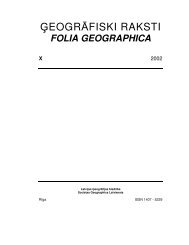eogrÄfiski raksti folia geographica xii - Ä¢eogrÄfijas un Zemes zinÄtņu ...
eogrÄfiski raksti folia geographica xii - Ä¢eogrÄfijas un Zemes zinÄtņu ...
eogrÄfiski raksti folia geographica xii - Ä¢eogrÄfijas un Zemes zinÄtņu ...
You also want an ePaper? Increase the reach of your titles
YUMPU automatically turns print PDFs into web optimized ePapers that Google loves.
45<br />
NATURE RESEARCH<br />
temperature curve is the same as that of the incoming short-wave radiation or net radiation.<br />
However, in the mid-day (10-13 local time) the received short-wave radiation was, on average,<br />
nearly as high as in J<strong>un</strong>e. The first frosts may occur and the leaf colouring begins, which comes<br />
about with a significant drop in temperature. The frost-free period comes gradually to an end.<br />
Early autumn is a short phase of transition from the summer air mass pattern Ps+Sp to<br />
winter P+A pattern. Starting from early autumn the equator-pole temperature gradient gradually<br />
gets stronger and, as a result, the westerly circulation starts strengthening and moving<br />
equatorward, i.e. a transition to winter circulation occurs. The frequency of subpolar air<br />
increases to a considerable extent and in the 11-year period comprised on average 25% (fronts<br />
excluded) or 13 days/month. The increase occurred at the expense of mid-latitude Sp and<br />
warmed subpolar Ps air, the frequency of which decreased 1.5-2 times. In early autumn, cold air<br />
masses (mA, cP) start arriving in Latvia, and their frequency in the 11-year period was almost<br />
20%. Maritime arctic air mA and continental subpolar air was identified in 8 years out of<br />
11 years with average frequency of 2-3 days. A couple of episodes with transformed maritime<br />
arctic air xA were noted in the third decade of 1993 and 1996. Yet, these were associated with<br />
the inflow of maritime arctic air mA, which briefly showed particularly low values of 850 hPa<br />
temperature and pseudopotential temperature, which could be related to xA air. The above cold<br />
air masses are those to cause the first killing frosts.<br />
It is noteworthy that the frequencies of maritime air (different air mass types) increased,<br />
and, along with the decrease of the frequency of continental air masses, the frequency of<br />
transformed maritime air masses decreased noticeably. The amo<strong>un</strong>t of precipitation was slightly<br />
higher compared to August.<br />
Toward the end of September, after the first frosts, a period of calm, s<strong>un</strong>ny weather with<br />
warm days, but cold nights and misty mornings may set in, yet it does not occur every year.<br />
This weather singularity, which is named “Old Wives’ summer” or summer-in-autumn, usually<br />
caused by an independent anticyclone formed either over European part of Russia or central<br />
Europe, lasts for at least three days (in Latvia, the longest period was aro<strong>un</strong>d 14 days).<br />
Sometimes such weather may set in during the first half of October. Regardless of the exact<br />
timing of the return of summer, this period is governed by mid-latitude and subtropical air,<br />
primarily, xSp, cSp, xS or even cS air. The diurnal temperatures vary greatly.<br />
Conclusions<br />
The location of Latvia in the area where on the one hand the boreal and nemoral zones<br />
and on the other hand the regions of oceanic and continental climate meet causes the landscapes<br />
to go through 12 seasonal states or seasons, which depend both on the annual cycle of insolation<br />
and air mass occurrence. Regarding the seasonal patterns of Latvia’s boreo-nemoral landscapes,<br />
the most notable conclusions are as follows.<br />
The period of positive net radiation is two times longer than the period of negative net<br />
radiation, and during 2.5 months (middle of May to end of July) the curve of mean annual net<br />
radiation has reached the highest values and stays at this level. This period of time (pre-summer,<br />
early summer and high summer) coincides with the main portion of the vegetation period and is<br />
typified by a large amo<strong>un</strong>t of precipitation. During this same period, in early summer,<br />
evaporation reaches yearly maximum and the time of minimum r<strong>un</strong>off sets in.<br />
The season with the highest upward gradients of net radiation and air temperature are<br />
early spring (starts just after vernal equinox or even before it) and full spring (second half of<br />
April to beginning of May). Yet, it is the time of the lowest amo<strong>un</strong>t of precipitation and the<br />
highest r<strong>un</strong>off, too. On the other hand, autumn equinox, which coincides with a steep downward<br />
gradient of net radiation and air temperature, opens the autumn season of maximum<br />
precipitation, very low evaporation and gradual increase of r<strong>un</strong>off, designated full autumn<br />
(October).<br />
In Latvia, just as throughout the whole boreo-nemoral ecotone, which belongs to the area<br />
of humid climate, on average 4 months/year (April-July) evaporation exceeds the amo<strong>un</strong>t of<br />
precipitation, 4 months/year (August-October, March) it is less than the amo<strong>un</strong>t of precipitation<br />
and the remaining 4 months (November-February) evaporation is small and may be considered<br />
as zero, but precipitated water is accumulated in the form of snow (and ice). Besides,

















